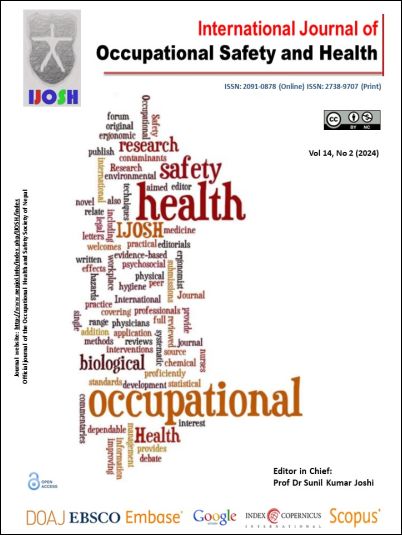Ergonomic Risk Identification and Postural Analysis in Electrical Transformers Manufacturing Company located in Southern India
DOI:
https://doi.org/10.3126/ijosh.v14i2.53692Keywords:
Ergonomics, MSDs, Postural Analysis, REBA, RULAAbstract
Introduction: Musculoskeletal disorders are the major factors resulting in discomfort at work in manufacturing industries to workers and these conditions contribute to the poor health of the workforce, subsequently to lower productivity. Therefore, the design of a workstation based on Ergonomic principles is becoming significant to reduce the effects of MSD. This study aimed to identify and assess the ergonomic risks associated with the work tasks in the company through posture analysis and develop recommendations for reducing those risks.
Methods: About 36 manufacturing workers from five sections were randomly selected for the cross-sectional study. The chosen team members were from Core building, Core winding, Assembly, Tanking and Tank fabrication sections with experience of more than two years. The presence of MSDs was assessed using a Nordic musculoskeletal questionnaire. For postural analysis, Rapid Upper Limb Assessment (RULA) and Rapid Entire Body Assessment (REBA) were utilized. Few selected postures were analysed using CATIAV5 software and improvements reducing the risks of postures were recommended.
Results: All of the 36 workers selected for the study were male with a mean age of 32 years and, average experience of 10 years, and 75% of workers had normal body mass index. The MSD questionnaire indicated discomfort of 86% mostly in the lower back portion of the body. The combined findings of RULA and REBA showed that about 44% of postures were in the high-risk group.
Conclusion: Well-defined ergonomic interventions such as redesigning the workstation are suggested to reduce awkward postures and manual handling risks, leading to improvement in job performance and productivity.
Downloads
Downloads
Published
How to Cite
Issue
Section
License
Copyright (c) 2024 The Author(s)

This work is licensed under a Creative Commons Attribution-NonCommercial 4.0 International License.
This license enables reusers to distribute, remix, adapt, and build upon the material in any medium or format for noncommercial purposes only, and only so long as attribution is given to the creator.





